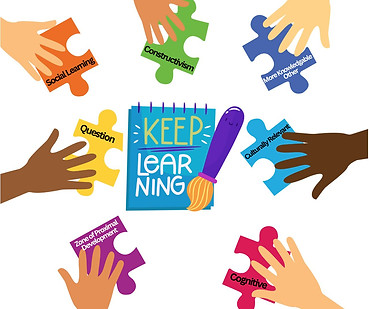Personal Theory of Learning
Personal Theory
of Learning
Stefanie McHorney-Enokian
Learning is a multifaceted, student-centered journey that moves beyond conventional
frameworks. It involves active engagement, collaborative exploration, and the
construction of knowledge through diverse experiences and social interactions.
Empowered by critical consciousness and cultural relevance, it fosters not only
understanding but also transformation, enabling learners to challenge inequities
and shape their reality.This theory of learning blends multiple theories, each
contributing a piece to the complex puzzle of how learning occurs.
At its core, learning is an active process where learners construct knowledge through experience and reflection. This process emphasizes the creation of tangible objects or ideas, allowing learners to engage deeply with the material and integrate new information with their existing knowledge base. Constructivism suggests that understanding is built through a dynamic interaction between the learner and their environment, fostering deeper comprehension and retention.
Jean Piaget's theory of cognitive development is fundamental to this constructivist view. Piaget proposed that learners actively construct their understanding through stages of development, each characterized by increasingly complex levels of thought (Cherry, K. 2022). According to Piaget, learning is driven by the processes of assimilation and accommodation, where learners integrate new information into existing cognitive structures and modify these structures in response to new experiences. This dynamic interplay between the learner and their environment facilitates the continuous construction and reconstruction of knowledge, emphasizing the importance of experiential learning and reflective thinking (Ackerman, E. 2001). While valuable, Piaget’s theory does not fully account for the social and collaborative aspects that are essential in comprehensive learning theories.
While behaviorism traditionally emphasizes external stimuli and observable behaviors, elements of reinforcement such as praise, grades and rewards can play a supportive role in motivating learners and reinforcing desired behaviors. The reinforcements can enhance engagement and compliance, particularly in structured learning environments, thereby facilitating meaningful interactions and learning experiences.
The collaborative process of learning is shaped significantly by social interactions and cultural contexts. Learners acquire knowledge through engagement with others, particularly those who are more knowledgeable. This interaction allows individuals to internalize new concepts and skills through observation, participation, and guided practice (Bandura, A., & Walter, R.H. 1971). Social contexts provide the framework within which learning occurs, influencing the ways in which knowledge is acquired and understood. Cultural influences play a crucial role, as they shape the values, norms, and practices that inform how individuals learn and interact with the world around them.
Central to this theory is Vygotsky’s concept of the "more knowledgeable other" (MKO), which highlights the importance of guidance and mentorship in the learning process. MKOs provide critical support, scaffolding the learner's development and helping them navigate complex concepts and tasks. This relationship is dynamic, evolving as the learner's competence grows, and it is essential for fostering independence and confidence in the learner Cherry, K. 2023).
Curriculum sequencing, spiraling (revisiting topics over time), and structured memorization provide foundational knowledge essential for efficient learning. While memorization alone does not equate to deep understanding, it supports the acquisition of basic facts and concepts that enable learners to make connections and apply knowledge in various contexts.
Learning also involves the development of critical consciousness, empowering learners to question and challenge existing inequities and injustices. This aspect of learning encourages individuals to engage with their reality in transformative ways, fostering a sense of agency and the ability to effect change. By recognizing and addressing cultural and social influences, learners can develop a more nuanced understanding of their world and their place within it (Ladson-Billings, G. 1995).
Learning is a holistic, interconnected process that cannot be fully explained by any single theory. It is an intricate tapestry woven from individual experiences, social interactions, cultural contexts, and guided mentorship. This theory of learning recognizes the importance of blending diverse approaches to create a comprehensive understanding of how learning happens, emphasizing the dynamic and transformative nature of the learning journey.
References
Ackerman, E. (2001). Piaget’s constructivism, Papert’s constructionism: What’s the difference. Future of learning group publication, 5(3), 1-11.
Bandura, A., & Walters, R. H. (1971). Social learning theory (Vol. 1). General Learning Press.
Cherry, K. (2022, November 2). Jean Piaget biography (1896 - 1980). Verywell Mind. https://www.verywellmind.com/jean-piaget-biography-1896-1980-2795549
Cherry, K. (2023, July 6). What is the zone of proximal development as defined by Vygotsky?. Verywell Mind. https://www.verywellmind.com/what-is-the-zone-of-proximal-development-2796034
Ladson-Billings, G. (1995). But that's just good teaching! The case for culturally relevant pedagogy. Theory Into Practice, 34(3), 159-165.

